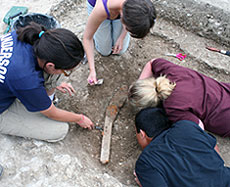7th century plough discovery redraws map of rural England by 400 years
Release Date 07 April 2011

A unique discovery made by the University of Reading could mean that the shape of our countryside was forged 400 years earlier than previously thought.
Dr Gabor Thomas and his team discovered Anglo-Saxon England's first iron plough coulter during excavations at Lyminge, Kent, as reported in tomorrow's British Archaeology. A coulter, one of the defining features of a ‘heavy plough', is a vertical soil slicer mounted like a knife to cut through the soil ahead of a plough share which improves a plough's efficiency.
The introduction of the heavy plough into Anglo-Saxon England has previously been assigned to the late 10th/11th centuries on the basis of representations in manuscripts of this period. Astonishingly however, the Lyminge coulter can be firmly dated to the 7th century.
Heavy-ploughs transformed the landscape. Unlike the small fields associated with earlier light ploughs they cultivated the land in long narrow strips making the large ‘open' fields which would become a standard feature of the medieval countryside.
Compared to light ploughs heavy ploughs, pulled by teams of eight oxen, were high-tech and fast. Crucially they permitted the cultivation of heavier soils, especially in areas of poor drainage, by creating a deep furrow characteristically known as ‘ridge and furrow'.
Dr Thomas from the University of Reading's renowned Department of Archaeology said: "The coulter was discovered at the base of a structure known as a ‘sunken featured building', common on settlements throughout Anglo-Saxon England. It looks to have been carefully placed at the bottom of the pit on the building's abandonment, perhaps as a ritual offering with symbolic connotations. What is most significant about this find, however, is that associated artefacts, diagnostic jewellery, glass, pottery, date the abandonment of the building and the coulter to the first half of the 7th century.
"While certain questions remain unanswered, the significance of the Lyminge coulter is considerable. With this technology in place, Anglo-Saxon landowners could maximise profits from their estates by bringing new land under cultivation and increasing the productivity of existing fields. This 7th-century wealth may have been invested in the establishment of England's earliest Christian monasteries as represented at Lyminge."
Peter Fowler, a leading Anglo-Saxon archaeologist and former professor of archaeology at Newcastle University, says the find is of huge significance.
"This is the object I have been waiting for all my life," Professor Fowler said. "It was known in Roman Britain but apparently then forgotten, and with a lack of evidence we believed that such a plough was unknown in England before the Late Saxon period. The possibility now exists that long before the formation of a unified England, at least some Anglo-Saxon farmers possessed a cultivating implement technically able to increase agricultural yields by ploughing more efficiently and more extensively, in a manner recognisable as distinctively ‘medieval'.
The 2010 excavation was the latest phase in a campaign of University of Reading research which has been systematically unearthing the remains of an Anglo-Saxon monastery preserved under the inhabited core of the village. The excavations are being funded by the British Academy, Society of the Antiquaries and the Royal Archaeological Institute.
The coulter is currently undergoing analytical conservation by a team at the Institute of Archaeology, UCL.
Ends
For all University of Reading media enquiries please contact James Barr, Press Officer tel. 0118 378 7115 or email j.w.barr@reading.ac.uk
News for Editors
The University of Reading's Department of Archaeology has an international reputation in research and teaching. The University was awarded the Queen's Anniversary Prize 2009 in recognition of the excellence of the archaeology department, which, uniquely within the study of archaeology, combines ground-breaking research, enterprise and teaching.
University of Reading is rated as one of the top 200 universities in the world (THE-QS World Rankings 2009).
The University of Reading is one of the UK's top research-intensive universities. The University is ranked in the top 20 UK higher education institutions in securing research council grants worth nearly £10 million from EPSRC, ESRC, MRC, NERC, AHRC and BBSRC. In the RAE 2008, over 87% of the university's research was deemed to be of international standing. Areas of particular research strength recognised include meteorology and climate change, typography and graphic design, archaeology, philosophy, food biosciences, construction management, real estate and planning, as well as law.
